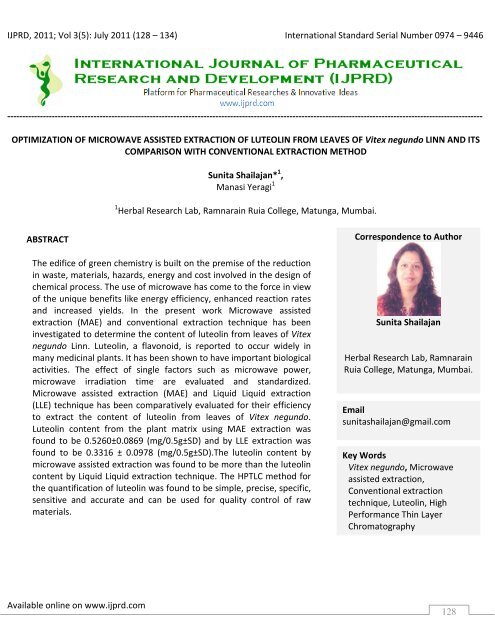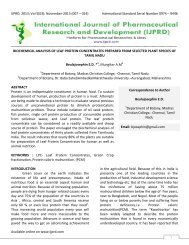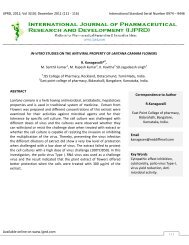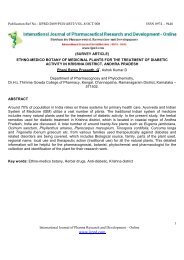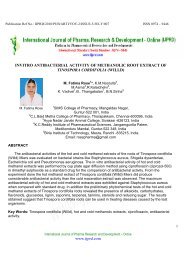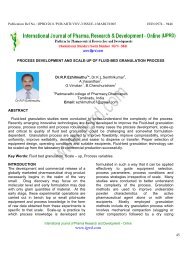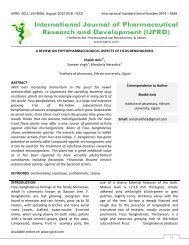OPTIMIZATION OF MICROWAVE ASSISTED EXTRACTION ... - IJPRD
OPTIMIZATION OF MICROWAVE ASSISTED EXTRACTION ... - IJPRD
OPTIMIZATION OF MICROWAVE ASSISTED EXTRACTION ... - IJPRD
Create successful ePaper yourself
Turn your PDF publications into a flip-book with our unique Google optimized e-Paper software.
<strong>IJPRD</strong>, 2011; Vol 3(5): July 2011 (128 – 134) International Standard Serial Number 0974 – 9446<br />
----------------------------------------------------------------------------------------------------------------------------------------------------------------<br />
<strong>OPTIMIZATION</strong> <strong>OF</strong> <strong>MICROWAVE</strong> <strong>ASSISTED</strong> <strong>EXTRACTION</strong> <strong>OF</strong> LUTEOLIN FROM LEAVES <strong>OF</strong> Vitex negundo LINN AND ITS<br />
COMPARISON WITH CONVENTIONAL <strong>EXTRACTION</strong> METHOD<br />
ABSTRACT<br />
Available online on www.ijprd.com<br />
Sunita Shailajan* 1 ,<br />
Manasi Yeragi 1<br />
1 Herbal Research Lab, Ramnarain Ruia College, Matunga, Mumbai.<br />
The edifice of green chemistry is built on the premise of the reduction<br />
in waste, materials, hazards, energy and cost involved in the design of<br />
chemical process. The use of microwave has come to the force in view<br />
of the unique benefits like energy efficiency, enhanced reaction rates<br />
and increased yields. In the present work Microwave assisted<br />
extraction (MAE) and conventional extraction technique has been<br />
investigated to determine the content of luteolin from leaves of Vitex<br />
negundo Linn. Luteolin, a flavonoid, is reported to occur widely in<br />
many medicinal plants. It has been shown to have important biological<br />
activities. The effect of single factors such as microwave power,<br />
microwave irradiation time are evaluated and standardized.<br />
Microwave assisted extraction (MAE) and Liquid Liquid extraction<br />
(LLE) technique has been comparatively evaluated for their efficiency<br />
to extract the content of luteolin from leaves of Vitex negundo.<br />
Luteolin content from the plant matrix using MAE extraction was<br />
found to be 0.5260±0.0869 (mg/0.5g±SD) and by LLE extraction was<br />
found to be 0.3316 ± 0.0978 (mg/0.5g±SD).The luteolin content by<br />
microwave assisted extraction was found to be more than the luteolin<br />
content by Liquid Liquid extraction technique. The HPTLC method for<br />
the quantification of luteolin was found to be simple, precise, specific,<br />
sensitive and accurate and can be used for quality control of raw<br />
materials.<br />
.<br />
Correspondence to Author<br />
Sunita Shailajan<br />
Herbal Research Lab, Ramnarain<br />
Ruia College, Matunga, Mumbai.<br />
Email<br />
sunitashailajan@gmail.com<br />
Key Words<br />
Vitex negundo, Microwave<br />
assisted extraction,<br />
Conventional extraction<br />
technique, Luteolin, High<br />
Performance Thin Layer<br />
Chromatography<br />
128
International Journal of Pharmaceutical Research & Development ISSN: 0974 – 9446<br />
INTRODUCTION<br />
Vitex negundo L. (Verbenaceae) is a hardy plant<br />
distributed in East Asia, south west China, throughout<br />
India and cultivated in Pakistan. All parts of the plant<br />
possess a multitude of phytochemical secondary<br />
metabolites which impart an unprecedented variety of<br />
medicinal uses to the plant. It is used for treatment of<br />
a wide spectrum of health disorders in traditional and<br />
folk medicine; some of which have been<br />
experimentally validated. The plant is a component of<br />
a number of commercially available Herbal, Ayurvedic<br />
and Unani formulations [1] . Vitex negundo leaves are<br />
reported to have various therapeutic activities like<br />
analgesic, anti-asthamatic, anti-rheumatic, astringent,<br />
antifungal, febrifuge, sedative, vermifuge and brain<br />
tonic. Vitex negundo leaves contain glucononitol, phydroxybenzoic<br />
acid,5-hydroxyisophthalic acid, 3,4<br />
dihydroxybenzoic acid, vitamin C, carotene, casticin ,<br />
orientin , isoorientin , luteolin, luteolin-7-0-glucoside,<br />
corymbosin, gardenins A and B, iridoid- agnuside,<br />
aucubin, nishindaside and negundoside etc [2] . Luteolin<br />
is one of the constituent of Vitex negundo leaves and<br />
possesses antioxidant<br />
Available online on www.ijprd.com<br />
[3] , cardiovascular [4,5] , anti-<br />
carcinogenic, anti-mutagenic, anti-angiogenic [6-9],<br />
estrogenic [10] , anti-obesity [11] , anti-viral [12] ,<br />
antibacterial [13] and gastroprotective properties [14] .<br />
The conventional methods operate through cell<br />
permeation followed by solubilising the active<br />
constituents by the extracting solvent. These<br />
conventional methods are time and solvent<br />
consuming, thermally unsafe. Liquid-liquid extraction,<br />
also known as solvent extraction and partitioning, is a<br />
method for extraction of a substance from one liquid<br />
phase into another liquid phase. The Microwave<br />
Assisted Extraction Process is a high-speed method<br />
used to selectively extract target compounds from<br />
various raw materials. Microwave assisted extraction<br />
uses energy of microwave radiation to heat solvents<br />
quickly and efficiently. With the increasing demand<br />
for more environmental friendly methods,<br />
Microwave assisted extraction is used for fast<br />
extraction of constituents from plant matrix [15, 16] .<br />
OBJECTIVE<br />
Present study describes the development and<br />
optimization of rapid, reliable and sensitive method<br />
of extraction of luteolin from Vitex negundo leaves<br />
using MAE and its comparison with conventional<br />
method (LLE) of extraction for amount of luteolin<br />
using HPTLC technique. This is the first report for<br />
quantitation of luteolin from Vitex negundo Linn.<br />
leaves using different extraction techniques. MAE<br />
thus, appears to be the most efficient and<br />
reproducible method of extraction and provides an<br />
alternative for extraction of pharmacologically<br />
important phytoconstituent like luteolin.<br />
EXPERIMENTAL<br />
Plant Material<br />
Leaves of Vitex negundo were collected from Malvan<br />
region of Maharashtra, India and were authenticated<br />
by Agharkar Institute (Auth08-72) and voucher<br />
specimens were deposited in Herbal Research Lab of<br />
Ramnarain Ruia College. The samples were powdered<br />
and sieved through 85 mesh size and stored in airtight<br />
containers for further use.<br />
Chemicals<br />
Analytical grade solvents Toluene, Ethyl acetate,<br />
Formic acid, Distilled Water were procured from<br />
Qualigens Fine Chemicals, Mumbai. Standard luteolin<br />
(≥ 98% purity) was procured from Sigma Aldrich,<br />
Germany. (Figure 1)<br />
Figure1. Structure of luteolin<br />
Microwave- assisted extraction<br />
129
International Journal of Pharmaceutical Research & Development ISSN: 0974 – 9446<br />
Microwave assisted extraction was performed on a<br />
modified domestic microwave oven (Model<br />
GMC25E09MRGX, Godrej, India) equipped with a<br />
magnetron of 2450 MHz with nominal maximum<br />
power of 700 W operated at 3 power levels and the<br />
time controller. Methanolic extract was selected for<br />
analysis since it gave maximum extraction in<br />
comparison with other solvents. Linearity was<br />
performed by varying the amount of drug and<br />
concentration of solvent. 500 mg dissolved in 10ml<br />
Methanol gave good resolution of bands using HPTLC<br />
technique which was optimised for further analysis.<br />
The plant powder was placed into the round bottom<br />
flask fitted with a water condenser in addition with<br />
solvent subjected to different time of irradiation and<br />
irradiation power. Before extraction the crude powder<br />
was soaked in 1 ml of distilled water for 2 minutes.<br />
After the extraction time had elapsed the vessels were<br />
allowed to cool to room temperature and the samples<br />
were centrifuged at 4000rpm.<br />
Optimisation of microwave power<br />
The extraction procedure was employed at 10%, 20%,<br />
30%, 40% and 50 % for microwave power optimisation.<br />
The extracts were further analysed by HPTLC for the<br />
concentration of Luteolin to optimize the power.<br />
Optimisation of microwave time<br />
The extraction procedure was employed at 1min, 3<br />
min, 5 min, and 10 min for microwave time<br />
optimisation. The extracts were further analysed by<br />
HPTLC for the concentration of Luteolin to optimize<br />
the power.<br />
Conventional Extraction technique<br />
Liquid-liquid Extraction (LLE) was performed in a clean<br />
stopper tube with different extraction solvents; the<br />
exhaustive extraction was performed on optimised<br />
amount of plant material with solvent. The extraction<br />
was performed for 12 hours on rotary shaker at 12-15<br />
rpm.<br />
HPTLC conditions<br />
Chromatographic separation was achieved on HPTLC<br />
plates (20 X 20 cm) precoated with silica gel 60 F254 (E.<br />
Merck) of 0.2 mm thickness with aluminium sheet<br />
support. Samples were spotted using CAMAG Linomat<br />
Table1. Linearity parameters<br />
Available online on www.ijprd.com<br />
IV Automatic Sample Spotter (Camag Muttenz,<br />
Switzerland) equipped with syringe (Hamilton, 100 µL).<br />
Plates were developed in a glass twin trough chamber<br />
(CAMAG, 20 X 10 cm) presaturated with mobile phase.<br />
Scanning device used was CAMAG HPTLC Scanner 2<br />
equipped with CATS3 software. The experimental<br />
condition was maintained at 25 ± 2 0 C.<br />
HPTLC FINGERPRINTING PR<strong>OF</strong>ILE<br />
Standard Stock and sample solution<br />
The stock solutions were transferred to volumetric<br />
flask in order to obtain aliquots of luteolin (20- 150<br />
µg mL -1 ) and volume was made upto 10 ml with<br />
methanol. Accurately weighed (500 mg) of plant<br />
powder was placed in a stoppered tube and 10 mL of<br />
methanol was added to it. The sample solutions<br />
extracted by MAE and by LLE techniques were further<br />
analyzed using HPTLC technique.<br />
Further three quality control samples (LQC: MQC:<br />
HQC) of Luteolin (25, 60, 120 µg mL-1) were prepared<br />
for precision, accuracy and ruggedness studies.<br />
Solvent system<br />
Solvent system consisted of Toluene: Ethyl acetate:<br />
Formic acid (3: 3: 0.8 v/v/v) has been used in this<br />
method to resolve and to quantitate luteolin from<br />
Vitex negundo leaves.<br />
Calibration Curve for luteolin<br />
For calibration curve the plate was scanned and<br />
absorption spectra were recorded at start, middle<br />
and end position of the band to check the purity of<br />
the band. The plates were scanned at 254 nm using<br />
CAMAG TLC Scanner 2 and CATS software. The peak<br />
areas were recorded. Calibration curve of luteolin<br />
was obtained by plotting peak areas vs.<br />
concentration of luteolin applied.<br />
METHOD VALIDATION<br />
ICH guidelines were followed for the validation of the<br />
developed analytical method (CPMP/ICH/281/95 and<br />
CPMP/ICH/381/95). (Table 1)<br />
130
International Journal of Pharmaceutical Research & Development ISSN: 0974 – 9446<br />
y = mx + c, y is peak area, m is the slope, x is the concentration and c is the intercept.<br />
Instrumental Precision<br />
Instrumental precision was checked by repeated<br />
scanning (n = 7) of the same spot of luteolin (100 µg<br />
mL -1 ) and further expressed as %CV.<br />
Repeatability<br />
The repeatability of the method was affirmed by<br />
analysing 60 µg mL -1 of luteolin on a TLC plate (n = 5)<br />
and expressed as %CV.<br />
Inter-Day and Intra-Day Precision<br />
Variability of the method was studied by analysing QC<br />
samples (25, 60, 120 µg mL -1 ) of luteolin on the same<br />
day (intra-day precision) and on different days<br />
(interday precision) and the results were expressed as<br />
%CV.<br />
Limit of Detection and Limit of Quantitation<br />
For the evaluation of limit of detection (LOD) and limit<br />
of quantitation (LOQ) different concentrations of the<br />
standard solutions of luteolin were applied along with<br />
methanol as blank and determined on the basis of<br />
signal-to-noise (S/N) ratio. LOD was determined at an<br />
S/N of 3: 1 and LOQ at an S/N of 10: 1.<br />
Recovery<br />
The accuracy of the method was assessed by<br />
performing recovery study at two different levels (25<br />
and 50 % spiking of luteolin in plant matrix). The<br />
percent recoveries and the average percent recoveries<br />
Available online on www.ijprd.com<br />
Parameters Result<br />
Linearity range 20 to 150 µg mL -1<br />
Slope (m) 15.672<br />
Intercept(c) 226.63<br />
Correlation coefficient (R) 0.997<br />
LOD 10 µg mL -1<br />
LOQ 20 µg mL -1<br />
System Suitability (n =5 % CV) 0.09<br />
Instrument Precision (n=6 % CV) 0.11<br />
Intraday (precision) (n=3 % CV) 1.62<br />
Interday (precision) (n=3 % CV) 1.12<br />
were calculated. It was carried out for sample<br />
extracted by MAE and LLE.<br />
Specificity<br />
Specificity was ascertained by analyzing standard<br />
compounds and samples. The band for luteolin from<br />
sample solution was confirmed by comparing the Rf<br />
and spectra of the band to that of the standard. The<br />
peak purity of the compound was analysed by<br />
comparing the spectra at three different levels, i.e.<br />
start, middle, and end positions of the bands.<br />
Ruggedness<br />
Ruggedness of the method was assessed by<br />
deliberately incorporating the small variations in the<br />
optimized chromatographic condition. Effect of<br />
change in analyst, change in mobile phase<br />
composition [Toluene: Ethyl acetate: Formic acid<br />
(3.1: 3: 0.8 v/v/v) and Toluene: Ethyl acetate: Formic<br />
acid (3: 3: 0.9 v/v/v)] and change in spotting volume<br />
(9 µL and 11 µL) on the response and Rf of quality<br />
control samples was observed.<br />
RESULTS<br />
For the extraction procedure employed for<br />
optimisation of power and time 30% power and 3<br />
min time was optimised for the extraction procedure<br />
according to the luteolin content.Of the various<br />
solvent systems tried, mixture containing Toluene:<br />
Ethyl acetate: Formic acid (3: 3: 0.8 v/v/v) gave the<br />
131
International Journal of Pharmaceutical Research & Development ISSN: 0974 – 9446<br />
best resolution of luteolin (Rf = 0.49) from the other<br />
components of the methanolic extract of Vitex<br />
negundo leaves. The identity of bands of luteolin in<br />
plant matrix was confirmed by overlay in UV<br />
absorption spectra with that of the standard luteolin<br />
using Camag TLC scanner 2. The purity of band of<br />
luteolin in the plant extract was confirmed by<br />
overlaying the absorption spectra at the start, middle<br />
and end position of the bands (Figure 4).<br />
Figure 3. Linearity of luteolin<br />
CONC<br />
3000<br />
2500<br />
2000<br />
1500<br />
1000<br />
500<br />
0<br />
LINEARITY <strong>OF</strong> LUTEOLIN<br />
y = 15.672x + 226.63<br />
R 2 = 0.9967<br />
0 50 100 150 200<br />
AREA<br />
Figure 4. Spectrum of MAE extracted and LLE<br />
extracted sample with luteolin standard<br />
The pharmacologically active phytoconstituent<br />
luteolin was quantified from Vitex negundo leaves by<br />
HPTLC densitometric method using MAE and LLE<br />
extraction technique. The developed method was<br />
validated in terms of precision, repeatability and<br />
accuracy (Table 1). The linearity range for luteolin<br />
was found to be 20 to 150 µg mL -1 with correlation<br />
coefficients (r values) 0.997, (Table 1).The TLC<br />
densitometric method was found to be precise with<br />
average % RSD for intra-day precision 1.62 and for<br />
inter-day precision 1.12 for different concentrations<br />
Available online on www.ijprd.com<br />
of luteolin (Table 1). This indicates that the method is<br />
precise. The LOD for luteolin was found to be 10 µg<br />
mL -1 and LOQ value was found to be 20 µg mL -1<br />
(Table 1) respectively. The average recovery at three<br />
different levels of luteolin was found to be 98.71 %<br />
(Table 2). Luteolin content from the plant matrix<br />
using MAE extraction was found to be 0.5260±0.0869<br />
(mg/0.5g±SD) and by LLE extraction was found to be<br />
0.3316 ± 0.0978 (mg/0.5g±SD). Ruggedness of the<br />
method by change in analyst and change in mobile<br />
phase composition showed variations within<br />
acceptable limits. Change in spotting volume at 9 and<br />
11 µL did not affect the Rf of examined<br />
phytoconstituent but change in response was<br />
observed which was within acceptable limits. Hence<br />
by using 0.5g of plant drug with 10 ml methanol with<br />
30% power gave the maximum yield of Luteolin in 5<br />
mins by MAE extraction than with LLE extraction for<br />
which the same amount of drug and solvent was<br />
used. This is the first method reported for<br />
quantitation of free luteolin content in leaves of Vitex<br />
negundo extracted by MAE and LLE technique (Fig.<br />
2).<br />
Figure 2. Chromatographic plate of LLE and MAE<br />
extract of Vitex negundo leaves with luteolin<br />
A B C<br />
Track A: LLE extract<br />
Track B: Luteolin Standard<br />
Track C: MAE extract<br />
132
International Journal of Pharmaceutical Research & Development ISSN: 0974 – 9446<br />
Table 2. Recovery of luteolin from Vitex negundo leaves<br />
DISCUSSION<br />
Microwave extraction can be performed at higher<br />
temperatures and extraction time can be reduced<br />
drastically. It is an innovative solvent-extraction<br />
technology, offers a superior alternative to conventional<br />
techniques owing to its efficient volumetric heat<br />
production. Considering the biological importance and<br />
wide occurrence of luteolin in plant materials this<br />
method has great advantages over the conventional<br />
extraction techniques. This method can be applied for<br />
the extraction of high-value compounds from natural<br />
sources including medicinally important constituents,<br />
phytonutrients, neutraceutical, functional food<br />
ingredients and pharma actives from biomass.<br />
REFERENCES<br />
1. Vishwanathan A. S., Basavaraju R., A Review on<br />
Vitex negundo L.- A Medicinally Important Plant,<br />
EJBS,3(1), 2010, 30.<br />
2. Zaware B.B, Nirmal S. A., An overview of Vitex<br />
negundo Linn.: Chemistry and Pharmacological<br />
profile.,RJPBCS,1(1),2010,104.<br />
3. Cotelle N.,Bernier J.L.,Catteau J.P., Pommery J.,<br />
Wallet J.C., Gaydou E.M., Antioxidant properties of<br />
hydroxy-flavones., Free Radic. Biol.Med.,<br />
20(1),1996, 35.<br />
4. Schussler M., Holzl J., Fricke U., Myocardial effects<br />
of flavonoids from Crataegus species,<br />
Arzneimittelforschung, 45(8),1995, 842.<br />
Available online on www.ijprd.com<br />
5. Occhiuto F., Busa G., Ragusa S., De P. A.,<br />
Cardiovascular effects of the aqueous extract of<br />
Gynostemma pentaphyllum Makino., Phytother.<br />
Res., 5, 1991, 9.<br />
6. Post, J.F.M., Varma R.S., Growth inhibitory effects<br />
of bioflavonoids and related compounds on human<br />
leukemic CEM-C1 and CEM-C7 cells, Cancer Lett.,<br />
67(2-3),1992,207.<br />
7. Elangovan V., Ramamoorthy N., Balasubramanian<br />
S., Sekar N., Govindasamy S., Studies on the<br />
antiproliferative effect of some naturally occurring<br />
bioflavonoidal compounds against human<br />
carcinoma of larynx and Sarcoma-180 cell lines,<br />
Indian J Pharmacol., 26(4),1994,266.<br />
8. Ryu S.Y., Choi S.U., Lee C.O., Lee S.H., Ahn J.W., Zee<br />
O.P., Antitumor triterpenes from medicinal plants,<br />
Arch.Pharm.Res.,17(1),1994,42.<br />
9. Fotsis T., Pepper M.S., Aktas E., Breit S., Rasku S.,<br />
Adlercreutz H., Wahala K., Montesano R.,<br />
Schweigerer L., Flavonoids Dietary-derived<br />
Inhibitors of Cell Proliferation and in Vitro<br />
Angiogenesis, Cancer Res., 57(14),1997, 2916.<br />
10. Hiremath S. P., Badami S., Hunasagatta S. K., Patil<br />
S. B., Antifertility and hormonal properties of<br />
flavones of Striga orobanchioides, Eur. J.<br />
Pharmacol., 391(1-2), 2000,193.<br />
133
International Journal of Pharmaceutical Research & Development ISSN: 0974 – 9446<br />
11. Kim J. S., Kwon C. S., Son K. H., Inhibition of alphaglucosidase<br />
and amylase by luteolin, a flavonoid.,<br />
Biosci. Biotechnol. Biochem., 64(11),2000,2458.<br />
12. Kusumoto I.T., Hattori M., Miyaichi Y., Tomimori T.,<br />
Hanaoka M., Namba T., Effects of Flavonoids and<br />
Alkaloids on Reverse Transcriptase., Shoyakugaku<br />
Zasshi, 45(3),1991, 240.<br />
13. Tsou M. F., Chen G. W., Hung C. F., Luteolin inhibits<br />
the growth and arylamine N-acetyl-transferase<br />
activity in Neisseria gonorrhoeae., Microbios, 104,<br />
2001, 87.<br />
14. Simoes C. M., Schenkel E. P., Bauer L., Langeloh A.,<br />
J.,Pharmacological investigations on Achyrocline<br />
Available online on www.ijprd.com<br />
*****<br />
satureioides(Lam.) DC. compositae.<br />
Ethnopharmacology, 22(3),1988, 281.<br />
15. Jyothi D., Khan S., Sultana R., Optimization of<br />
Microwave Assisted Extraction of Withanolides<br />
from roots of Ashwagandha and its comparison<br />
with conventional extraction method.,<br />
International Journal of Pharmacy and<br />
Pharmaceutical Sciences, 2(4), 2010, 46.<br />
16. Jain T., Jain V., Pandey R., Vyas A., Shukla S.S.<br />
Microwave assisted extraction for<br />
phytoconstituents-An overview, Asian J. Research<br />
Chem., 2(1), 2009,7.<br />
134


